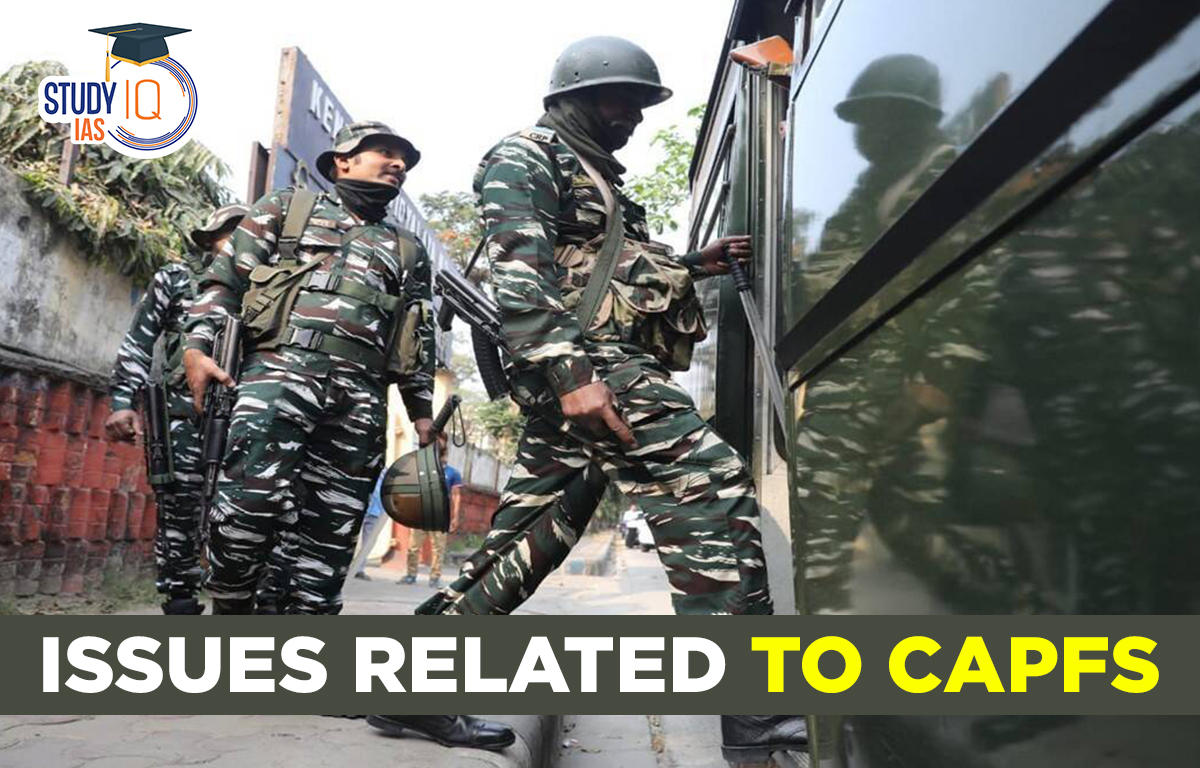Table of Contents
Context: 436 personnel died by suicide in the Central Armed Police Forces (CAPFs) in the last three years, according a recent study by a taskforce of home ministry.
What are the Central Armed Police Forces (CAPFs)?
- Central Armed Police Forces is the collective name of central police organizations (CPOs) in India under the Ministry of Home Affairs.
- These are technically paramilitary forces formerly known as Central Para-Military Forces (CPMF). Since 2011, India adopted the term “central armed police forces” to drop the word “paramilitary”.
- A paramilitary force is an organization that operates similarly to a military force but is not part of the regular armed forces of a country.
- Armed forces of India: The Indian Armed Forces comprise of three divisions – Indian Army, Indian Navy, and the Indian Air Force (under the management of the Ministry of Defence).
- Mandate of CAPFs: These forces are responsible for internal security and guarding the borders.
- Current CAPFs: There are 7 security forces in CAPF namely– Central Reserve Police Force (CRPF), Central Industrial Security Force (CISF), Sashastra Seema Bal (SSB), Assam Rifles (AR), Indo-Tibetan Border Police (ITBP), National Security Guards (NSG) and Border Security Forces (BSF).
- They function under the administrative control of Ministry of Home Affairs.
- Though the AR functions under the administrative control of the MHA, its operational control rests with the Ministry of Defence.
- Border guarding forces: Of the CAPFs, the AR, BSF, ITBP and SSB are Border Guarding Forces.
- The Border Security Force (BSF) is responsible for guarding India’s land borders with Pakistan and Bangladesh.
- The Assam Rifles (AR) is responsible for guarding India’s borders with Myanmar.
- The Indo-Tibetan Border Police (ITBP) is responsible for guarding India’s border with China.
- The Sashastra Seema Bal (SSB) is responsible for guarding India’s borders with Nepal and Bhutan.
- The NSG: The NSG is a commando trained force Organisation in India and are used for special operations.
- The CISF: The CISF provides security and protection to industrial undertakings and vital installations.
- The CRPF: The CRPF is deployed in aid of civil power in matters relating to maintenance of law and order, internal security and counterinsurgency.

What are the various issues faced by the Central Armed Police Forces (CAPFs)?
- Working Conditions: The Standing Committee on Home Affairs in the year 2017 had expressed concern over the working conditions of personnel of the border guarding forces.
- The Committee observed that they had to work 16-18 hours a day, with little time for rest or sleep.
- The personnel were also not satisfied with medical facilities that had been provided at border locations.
- In addition, the Standing Committee observed that personnel of the CAPFs have not been treated at par with the Armed Forces, in terms of pay and allowances.
- Rising suicides: 436 personnel died by suicide in the Central Armed Police Forces (CAPFs) and Assam Rifles (AR) in the last three years, according a recent study by a taskforce of home ministry.
- Ineffective Coordination Between State Police and The CAPF Leadership: States are overdependent on the CRPF for maintaining various law and order situations. The continuous deployment of training companies affects the operational efficiency of the CRPF, as well as denies them training and rest.
- Vulnerability to attacks: The deployment levels of CRPF personnel are high and they are overstretched, leading to compromised training and vulnerability to attacks.
- On February 14, 2019, a terror attack was carried out in Pulwama in Jammu and Kashmir by a suicide bomber resulting in the death of 40 CRPF personnel.
- Bureaucratization of the forces: Majority of the higher posts of the top hierarchy are filled by deputations (IPS officers), who most of the times failed to take adequate steps for the welfare of the cadre officers.
- Poor Infrastructure: Lack of electricity at several installations of Border Out Posts (BOPs), seriously affects the working conditions of the personnel as well as operations of the CAPFs.
- These affect the overall moral of the forces leaving them psychologically vulnerable. Often incidences of suicides and shooting down of the colleagues come in the light.
Way Forward
In 2018, a report by the Standing Committee on Home Affairs on ‘Working Conditions in Central Armed Police Forces’ has suggested the following recommendations:
- Ending IPS hegemony: The nature of duty of CAPF is more like that of the Armed Forces and it would make more sense to bring more officers from the Armed Forces on deputation. However, MHA has contested the same by justifying that the presence of IPS officers in every CAPF increases inter-departmental coordination between various CAPFS and State and therefore IPS officers are best suited to lead and provide supervisory directions to any CAPFs in an effective, efficient and impartial manner.
- Modernization of the Force must be given utmost priority as this Force not only has to face any enemy from across the border but also vagaries of nature.
- Issue specific Counter Plan rather than One-Size Fits All Approach:
- For J&K: MHA should adopt a multi-pronged strategy that prevents youth from joining militancy, curbs their financing, and simultaneously launch counter-insurgency operations.
- For Left Wing Area: MHA should make efforts to procure mine-resistant vehicles. This could be done through import or domestic manufacturing under the ‘Make in India’ programme,
- Cadre Review: Expedite Cadre Review of these forces as it’s is essential to maintain their organizational structure and ensures completion of project in a time-bound manner.
- Setting up Dedicated Research and Development (R&D) Wing: It recommended that due to the unique issues faced by the CRPF, such as large size and areas of deployment, creation of a dedicated R&D unit of its own should be explored, to deal with issues peculiar to the CRPF such as Improvised Explosive Devices (IEDs), and bullet proofing of vehicles.


 Editorial of the day (18th Apr): Great I...
Editorial of the day (18th Apr): Great I...
 Expansion of Universe, Speed, Reasons, I...
Expansion of Universe, Speed, Reasons, I...
 Current Affairs 18th April 2024 for UPSC...
Current Affairs 18th April 2024 for UPSC...

















